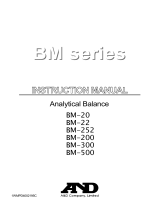
1
CONTENTS
1. INTRODUCTION ............................................................................................................................ 2
1-1 Unpacking the Tester ..........................................................................................................................2
1-2 Description of Each Component .........................................................................................................3
1-3 WinCT-Pipette, Software for Pipette Accuracy Testing .......................................................................4
1-4 Function of the Evaporation Trap........................................................................................................5
1-5 Description of the Sample Cup ...........................................................................................................5
2. ASSEMBLING THE TESTER......................................................................................................... 6
2-1 Preparing to Assemble the Tester .......................................................................................................6
2-2 Assembling the Tester .........................................................................................................................7
3. PRECAUTIONS BEFORE USE.................................................................................................... 10
4. ANTI-STATIC TREATMENT ......................................................................................................... 11
5. INSTALLING WinCT-Pipette........................................................................................................ 11
6. CONNECTING A PC TO THE BALANCE .................................................................................... 12
6-1 Connecting a PC ...............................................................................................................................12
6-2 Checking COM Port Numbers ..........................................................................................................13
7. CALIBRATING THE BALANCE................................................................................................... 14
7-1 Calibrating Using the Internal Mass (Calibration of balance)............................................................14
8. PREPARATION BEFORE USE .................................................................................................... 15
8-1 Filling the Evaporation Trap with Water ............................................................................................15
8-2 Preparing the Test Liquid ..................................................................................................................15
8-3 Preparing the Water-absorbent Sheet ..............................................................................................15
8-4 Using the Thermometer ....................................................................................................................16
9. MEASUREMENT.......................................................................................................................... 22
9-1 Measuring Procedure........................................................................................................................22
9-2 Judging the Results...........................................................................................................................22
9-3 Example Causes of Measurement Errors .........................................................................................22
10. FUNCTION SETTING OF THE BALANCE ................................................................................ 24
10-1 Display Lock Function .....................................................................................................................24
10-2 Auto Print Mode...............................................................................................................................24
11. TROUBLESHOOTING................................................................................................................ 25
12. OPTIONS.................................................................................................................................... 26
13. APPENDIX.................................................................................................................................. 27



























